NGC Ancients: The Tetrarchy of Diocletian
Posted on 4/10/2012
The last two months of AD 284 marked a crisis point for the Roman Empire. For over a century, the fortune of the Roman people had declined from a high point in the mid-second century AD to barely livable conditions. Drastic change in the political realm was badly needed if the Empire was to survive the so-called “Crisis of the Third Century,” and it was largely due to one man that such reform was realized for a brief period of time.
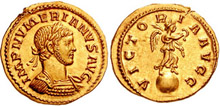
With the death (probable murder) of the emperor Numerian (AD 283-284) as he returned from a campaign in Persia in November 284, a man of humble origins who had risen through the ranks of the army, Diocletian (AD 284-305), was chosen by the Roman Army as his successor. After securing power and executing the presumed murderer of Numerian, Diocletian quickly took steps to stabilize the government of the Empire.
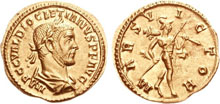
To this end, Diocletian took a step almost without precedent in Roman history: in the summer of 285, he elevated the commander Maximian (AD 286-305) to the rank of Caesar. Maximian essentially functioned as co-ruler with Diocletian until he was officially granted the title of Augustus in the spring of 286. 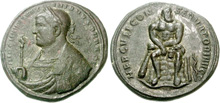 Because Diocletian felt that the emperorship was too big a job for one man, he delegated military duties to Maximian in the West while he defended the East and focused on social and economic reforms. Maximian’s military prowess was an ideal counterpart to the more intellectual aims of Diocletian.
Because Diocletian felt that the emperorship was too big a job for one man, he delegated military duties to Maximian in the West while he defended the East and focused on social and economic reforms. Maximian’s military prowess was an ideal counterpart to the more intellectual aims of Diocletian.
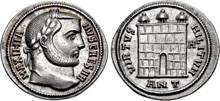
After several years of joint rule, both emperors recognized the need for further assistance in matters of government. This is more than understandable, as Diocletian was attempting radical reformation of Roman society, and Maximian was preoccupied much of the time with putting down rebellions. In 293, Diocletian chose Galerius as his Caesar while Maximian did the same with Constantius I. 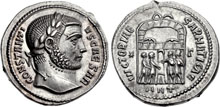
Now, the Empire was essentially ruled by a committee of four men; the “tetrarchy” of Diocletian had been established. Unfortunately, this delegation of power and mitigation of military risk came at the expense of greatly increased bureaucracy, which meant a greater tax burden.
During his 21 years at the helm, Diocletian secured his place as one of the major reformers of Roman coinage. Starting in about 293 or 294, he stabilized the value of a gold aureus at 60 to the Roman pound, and introduced new denominations to replace the existing billon and base metal coinages.
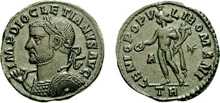
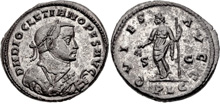
Diocletian introduced the nummus (or follis), a relatively large (c.25-27mm) and thin (c.7-10g) billon coin that contained about 5% silver. Often, much of the low silver content was concentrated on the surface to give the illusion of value, resulting in an effect termed “silvering” by NGC. Amazingly, some of these coins have retained this beautiful, original surface over the better part of two millennia. For purposes of comparison, two nummi of Diocletian are illustrated here: the first, struck in Trier c.298-299, contains no hint of the original, “silvered” surface, while the other example, struck at Lyon c.307, appears quite similar to the day it was struck, with its lustrous surfaces largely preserved.
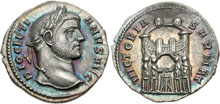
In addition to the nummus, Diocletian was also responsible for introducing the argenteus, a coin of high-purity silver roughly the size of today’s U.S. dime. They were struck at 96 to the Roman pound; this beautiful example of a Diocletian argenteus was likely struck in 294, at the very beginning of that emperor’s attempts at major economic reform. It features his bust on the obverse, and on the reverse a depiction of the tetrarchs sacrificing before city gates.
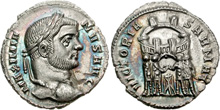
To illustrate the similarity of portraiture that appeared on Roman coins of this time period, compare the above to this argenteus of Maximian. Note the consistency of style: large, squared-off faces and prominent, well-defined beards were the order of the day. This similarity of style extended to all four of the tetrarchs and their immediate successors. In particular, issues of Maximian and Galerius can be difficult to distinguish, and often must be attributed on the basis of minute variations in the obverse inscriptions.
Despite Diocletian’s best intentions, his ambitious reforms were doomed to failure. His plans for economic reform fell apart when the argenteus was hoarded or exported for its high silver content, leaving the lowly nummus to function as the workhorse of the system, a situation not unlike that of the American Civil War, when silver issues largely disappeared from circulation for the same reasons (i.e. a volatile economy that mostly functioned underground). Rampant inflation would force a revaluation of the argenteus within a decade of its appearance.

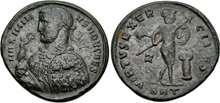
In 305 Diocletian and Maximian “voluntarily” abdicated the throne, the first time a Roman emperor’s tenure was not concluded by his own death. The Caesars Galerius and Constantius I now assumed the rank of Augustus, and, in turn, Severus II and Maximinus II Daia took their place in the tetrarchy. Both men were selected by the ambitious Galerius due to their loyalty to him, which contributed to the quick failure of this new governing body. A follis of each new Caesar is illustrated here, with the issue of Maximinus II Daia displaying a rare and unusual bust style for the period. The inevitable disintegration of Galerius’ new tetrarchy led to unfortunate civil wars until 324, when one of the contenders, Constantine I “the Great” (AD 307-337), finally secured power in the West.
Though Diocletian was ultimately unable to reverse the long, slow decline of the Roman Empire, his efforts at reform should be lauded, especially when one considers the gravity of the situation he faced upon assuming the purple in 284. He broke with tradition and tried to establish new systems more in accordance with his volatile era.
From a collecting standpoint, this time period (c.284-c.324) offers a wide array of coinage of almost twenty emperors (or would-be emperors). Though the simplicity and repetition of style and fabric will not be to everyone’s taste, to specialists they are the most compelling elements. Many of these issues are obtainable in excellent condition at very reasonable prices, due in no small part to enormous production at the time. They offer a glimpse of a fascinating and uncertain period in the history of the Roman Empire, and serve as a lasting testament to the man who tried to save it.
Images courtesy of Classical Numismatic Group.
Stay Informed
Want news like this delivered to your inbox once a month? Subscribe to the free NGC eNewsletter today!
